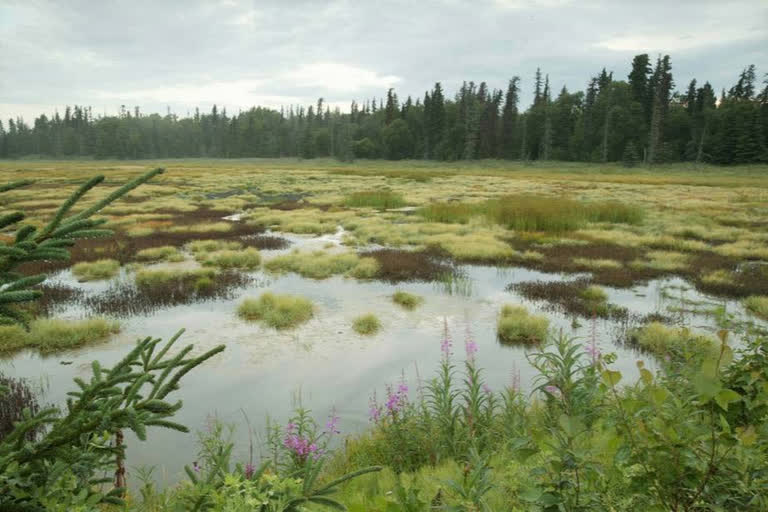Hyderabad: World Wetlands Day is celebrated internationally each year on 2 February to raise global awareness about the high importance of wetlands for us and our planet. Today marks the 50th Anniversary of the Ramsar Convention where on 2 February 1971 the world adopted the 'Convention on Wetlands' in the Iranian city of the shores of the Caspian Sea.
This year's theme for World Wetlands Day is 'Wetlands and water' that shines a spotlight on wetlands being a source of freshwater and encourages actions to restore them and stop their loss.
The reason behind marking this day is to talk about the depleting wetlands that are a major source of fresh water, something of which we are facing a growing crisis. We use more freshwater than nature can replenish which is concerning since these fresh and saltwater wetlands sustain life and nature. They support our social and economic development through multiple services.
The 2021 campaign highlights the contribution of wetlands to the quantity and quality of freshwater on our planet. Water and wetlands are connected in an inseparable co-existence that is vital to life, our wellbeing and the health of our planet.
What are Wetlands:
Wetlands are land areas that are saturated or flooded with water either permanently or seasonally. Inland wetlands include marshes, ponds, lakes, fens, rivers, floodplains, and swamps. Coastal wetlands include saltwater marshes, estuaries, mangroves, lagoons and even coral reefs. Fishponds, rice paddies, and saltpans are human-made wetlands.
Also read: Brazil's horrific blaze kills 200 jaguars, reptiles
Importance of Wetlands:
Wetlands are among the most diverse and productive ecosystems. They provide essential services and supply all our fresh water.
Wetlands are vital for human survival. They are among the world’s most productive environments; cradles of biological diversity that provide the water and productivity upon which countless species of plants and animals depend for survival. Wetlands are indispensable for the countless benefits or “ecosystem services” that they provide humanity, ranging from freshwater supply, food and building materials, and biodiversity, to flood control, groundwater recharge, and climate change mitigation.
Functions of wetlands do:
1. Store and clean water
- Wetlands hold and provide most of our freshwater.
- They naturally filter pollutants, leaving water we can safely drink.
2. Keep us fed
- Aquaculture is the fastest-growing food production sector, while inland fisheries alone provided 12 million tonnes of fish in 2018.
- Rice paddies feed 3.5 billion people annually.
3. Underpin our global economy
- Wetlands, the most valuable ecosystem, provide services worth US $47 trillion a year.
- More than one billion people rely on wetlands for income.
4. Provide nature a home
- 40% of the world’s species live and breed in wetlands. Annually, about 200 new fish species discovered in freshwater wetlands.
- Coral reefs are home to 25% of all species.
5. Keep us safe
- Wetlands provide protection from floods and storms with each acre of wetland absorbing up to 1.5 million gallons of floodwater.
- Wetlands help regulate the climate: peatlands store twice as much carbon as forests, with salt marshes, mangroves, and seagrass beds also holding vast amounts of carbon.
Need to conserve Freshwater
Since only 2.5 per cent of the water on Earth is freshwater and we use 10 billion tons of fresh water every day mostly stored in the form of glaciers, ice caps and underground aquifers it becomes highly important to keep a check on its usage. Rivers and Lakes hold 0.3% of surface water.
Water use increased six-fold in 100 years and rises by 1 per cent annually with 70 per cent used for food cultivation and 22 per cent consumed by industry and energy.
Also read: Firefighters tackle ravaging Amazon wildfires
What makes it more precious is the fact that less than 1 per cent of fresh water is usable.
Wetlands in India:
India is endowed by a rich diversity of wetlands ranging from high altitude wetlands of Himalayas, floodplains of mighty rivers as Ganges and Brahmaputra, lagoons and mangrove marshes on the coastline and reefs in the marine environments.
As per National Wetland Atlas, nearly 4.7% of India’s geographical area is under wetlands.
India became a party to the Ramsar Convention in 1982, and as on January 2020 has designated 37 wetlands as Ramsar Sites under the 9 designation criteria of the Convention. The Ministry of Environment, Forest and Climate Change, as the nodal Ministry for wetlands conservation has been assisting State Governments since 1985 in design and implementation of integrated management plans.
Financial assistance has been provided to State Governments for implementation of management plans for 180 wetlands.
In 2017, the Ministry has also notified the Wetlands (Conservation and Management) Rules as the regulatory framework for wetlands in the country. Several states have also notified wetland authorities and acts and rules for conservation and wise use of wetlands.


